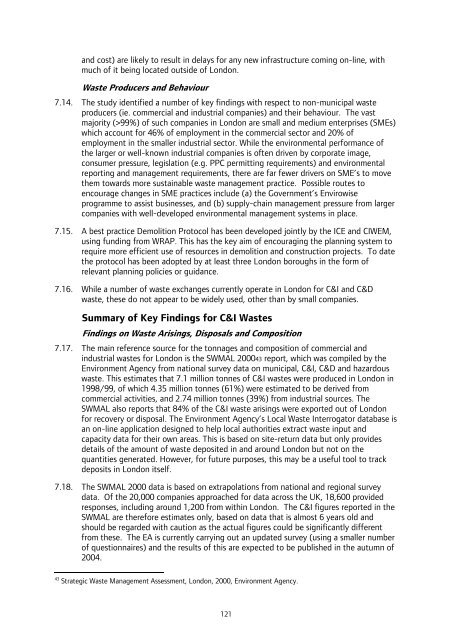London Wider Waste Strategy - London - Greater London Authority
London Wider Waste Strategy - London - Greater London Authority
London Wider Waste Strategy - London - Greater London Authority
Create successful ePaper yourself
Turn your PDF publications into a flip-book with our unique Google optimized e-Paper software.
and cost) are likely to result in delays for any new infrastructure coming on-line, with<br />
much of it being located outside of <strong>London</strong>.<br />
<strong>Waste</strong> Producers and Behaviour<br />
7.14. The study identified a number of key findings with respect to non-municipal waste<br />
producers (ie. commercial and industrial companies) and their behaviour. The vast<br />
majority (>99%) of such companies in <strong>London</strong> are small and medium enterprises (SMEs)<br />
which account for 46% of employment in the commercial sector and 20% of<br />
employment in the smaller industrial sector. While the environmental performance of<br />
the larger or well-known industrial companies is often driven by corporate image,<br />
consumer pressure, legislation (e.g. PPC permitting requirements) and environmental<br />
reporting and management requirements, there are far fewer drivers on SME’s to move<br />
them towards more sustainable waste management practice. Possible routes to<br />
encourage changes in SME practices include (a) the Government’s Envirowise<br />
programme to assist businesses, and (b) supply-chain management pressure from larger<br />
companies with well-developed environmental management systems in place.<br />
7.15. A best practice Demolition Protocol has been developed jointly by the ICE and CIWEM,<br />
using funding from WRAP. This has the key aim of encouraging the planning system to<br />
require more efficient use of resources in demolition and construction projects. To date<br />
the protocol has been adopted by at least three <strong>London</strong> boroughs in the form of<br />
relevant planning policies or guidance.<br />
7.16. While a number of waste exchanges currently operate in <strong>London</strong> for C&I and C&D<br />
waste, these do not appear to be widely used, other than by small companies.<br />
Summary of Key Findings for C&I <strong>Waste</strong>s<br />
Findings on <strong>Waste</strong> Arisings, Disposals and Composition<br />
7.17. The main reference source for the tonnages and composition of commercial and<br />
industrial wastes for <strong>London</strong> is the SWMAL 200043 report, which was compiled by the<br />
Environment Agency from national survey data on municipal, C&I, C&D and hazardous<br />
waste. This estimates that 7.1 million tonnes of C&I wastes were produced in <strong>London</strong> in<br />
1998/99, of which 4.35 million tonnes (61%) were estimated to be derived from<br />
commercial activities, and 2.74 million tonnes (39%) from industrial sources. The<br />
SWMAL also reports that 84% of the C&I waste arisings were exported out of <strong>London</strong><br />
for recovery or disposal. The Environment Agency’s Local <strong>Waste</strong> Interrogator database is<br />
an on-line application designed to help local authorities extract waste input and<br />
capacity data for their own areas. This is based on site-return data but only provides<br />
details of the amount of waste deposited in and around <strong>London</strong> but not on the<br />
quantities generated. However, for future purposes, this may be a useful tool to track<br />
deposits in <strong>London</strong> itself.<br />
7.18. The SWMAL 2000 data is based on extrapolations from national and regional survey<br />
data. Of the 20,000 companies approached for data across the UK, 18,600 provided<br />
responses, including around 1,200 from within <strong>London</strong>. The C&I figures reported in the<br />
SWMAL are therefore estimates only, based on data that is almost 6 years old and<br />
should be regarded with caution as the actual figures could be significantly different<br />
from these. The EA is currently carrying out an updated survey (using a smaller number<br />
of questionnaires) and the results of this are expected to be published in the autumn of<br />
2004.<br />
43 Strategic <strong>Waste</strong> Management Assessment, <strong>London</strong>, 2000, Environment Agency.<br />
121
















